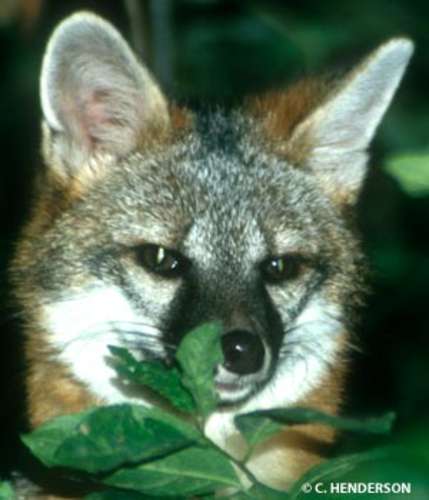Gray foxes Mysterious Minnesota arboreal canids

The best times to hope for a glimpse of the gray fox are dawn and dusk.
Photo: C. Henderson, courtesy of the MNDNR
Once, I spotted a gray fox in Minneapolis near the Mississippi River. Although Urocyon cinereoargenteus is a fairly common species in many parts of Minnesota, I counted myself as fortunate as they are difficult to spot. Shy and primarily nocturnal, the best time of day to catch a glimpse of one of these small canids is dawn or dusk. Gray fox can be mistaken for red fox, as they do have some red in their coat, but their gray fur is dominant. They also lack the black socks of red fox, and have a black rather than white tail tip.
The smallest of Minnesotas canid species, the gray fox seems almost cat-like in both its size and behavior. Though taller than a house cat, it weighs in about the same at eight to 14 pounds. Amazingly, this canid climbs trees and not just sloping trunks like some dogs can wriggle up, but vertical trees with nearly smooth bark. Gray foxes strong hooked claws enable them to be quite at home in the treetops, and they are the only canid in the western hemisphere with this ability. (There is one more canid that can climb trees in the world: the Asian raccoon dog.) Their interest in climbing trees is mainly to escape predators, primarily coyotes, and also to find food, such as eggs and nestlings. Typically, they den in a hollow tree or log, in a burrow made by another animal, or in a rock crevice.
At this time of year, gray fox begin mating. One sign of their activity is territorial urine markings on snow. Kits will be born in two months, just in time for the abundance of small wildlife that becomes available in spring as the snow melts away. Gray fox are omnivores, but cottontail rabbits are their most common prey. Voles and mice are also frequently on the menu, as well as insects and fruits later in the season.
Gray fox are presumed to be monogamous with pairs staying together to raise the young, but this is undocumented. The gestation period has been reported at 53 and 63 days, with no conclusive record. There is surprisingly a lot that is not known about gray foxes, perhaps because they are neither a bother to humans (they dont raid chicken pens or grain stores) nor of much economic value (in terms of pelts).
For more information on this beautiful but rarely seen animal, please visit:
- The Minnesota Department of Natural Resources,
- Gray fox is seldom seen Minnesota canid from Northland Outdoors,
- the Fish and Wildlife Service database, and
- The Mammals of Minnesota, by Evan B. Hazard.